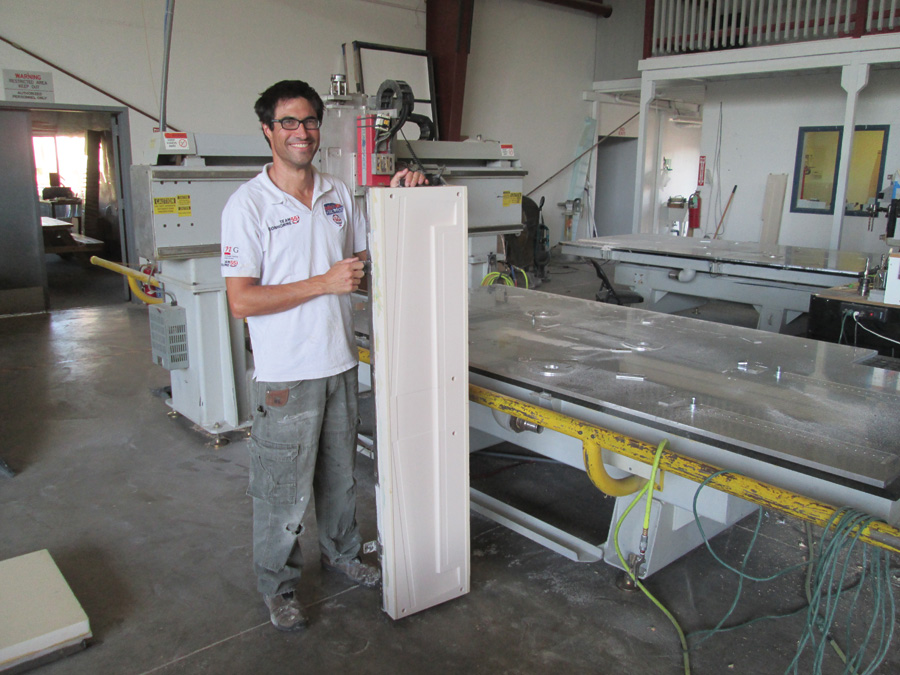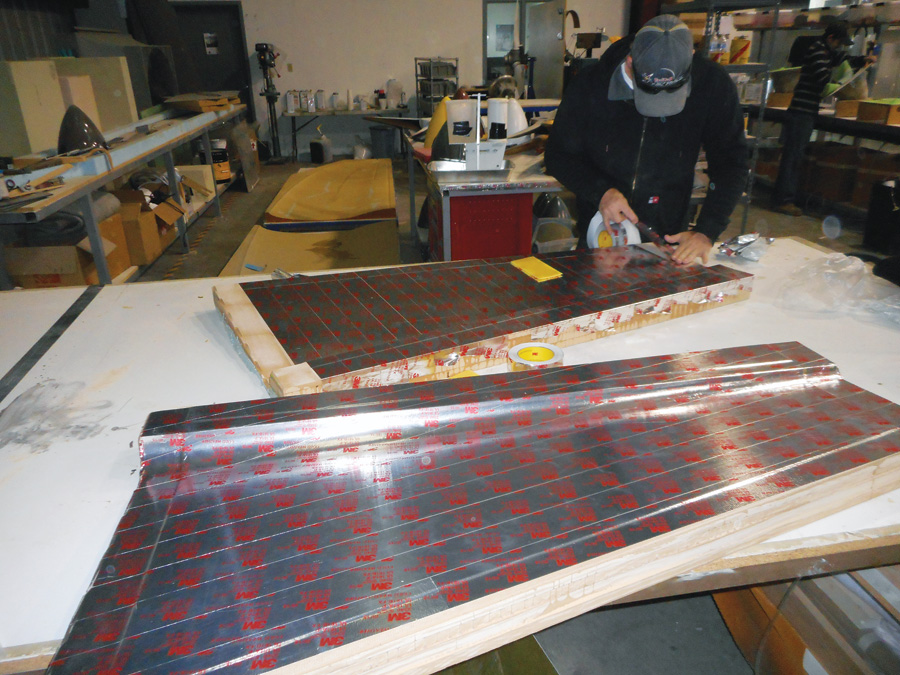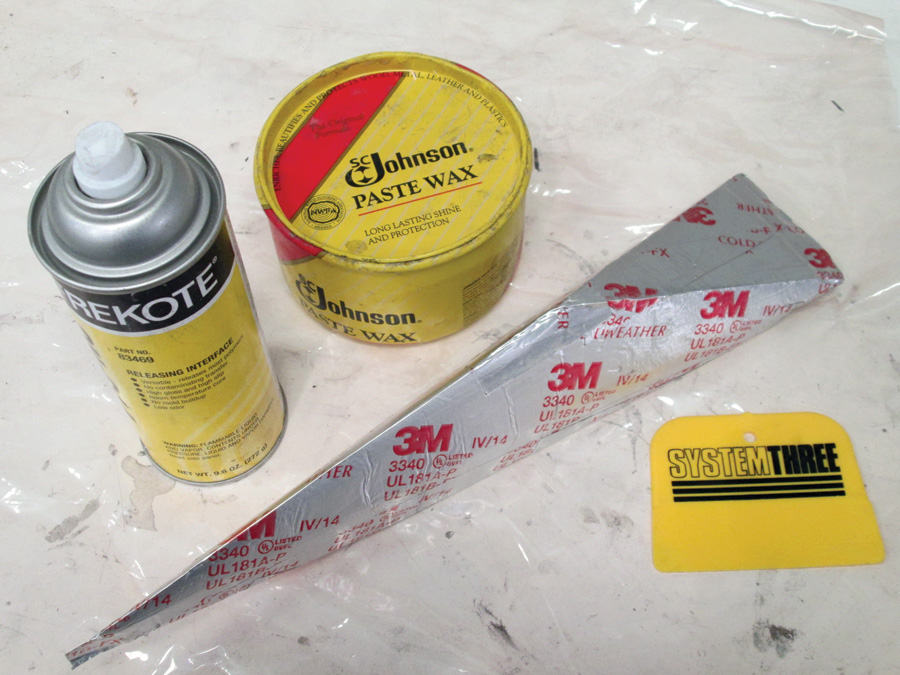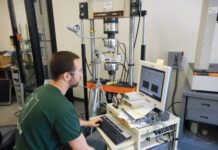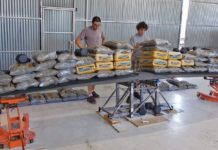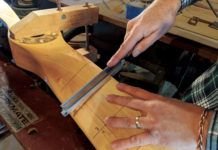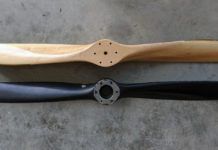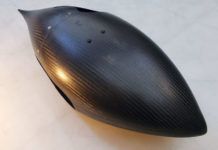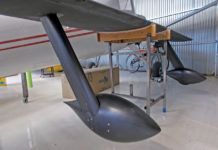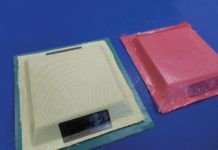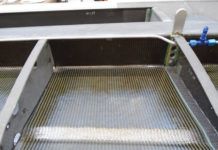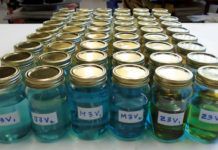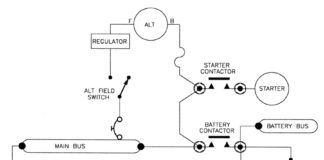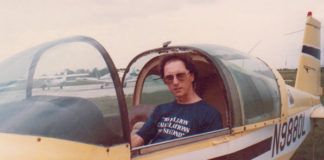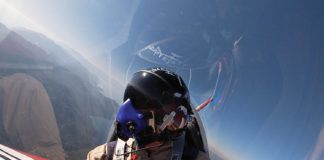In last month’s article we discussed making relatively cheap, simple tooling blanks for rapid prototyping of CNC’d composite parts. In that article we discussed the overall approach to fabricating the blanks, as well as a more detailed description of the mold substructure. In this month’s article, we’ll look at bonding the tooling foam blanks to the frames and mounting them to the CNC table, as well as some other approaches to rapid prototyping of composite parts.
Vacuum Bagging the Blanks
For long, narrow mold blanks such as control surfaces, the easiest method of bagging is to simply use Aerospace Composite Products (ACP) nylon vacuum bag tube and quick-lock seals. For larger blanks, such as a wing or fuselage, a custom bag should be assembled beforehand. Although you can use Stretchlon or one of ACP’s similar bagging plastics, I have found that 6-mil plastic sheeting from the aviation department at Lowe’s works OK if you handle it with care. Cut the bag so that when folded in half, you have a 12-inch margin around the perimeter of your mold. In other words, the bag for a 2×5-foot mold would be a sheet of plastic 8×7 feet that folds into a bag 4×7 feet. Apply ACP’s low-temp sealant tape around the bottom half of the bag, leaving the wax paper in place until you close the bag.
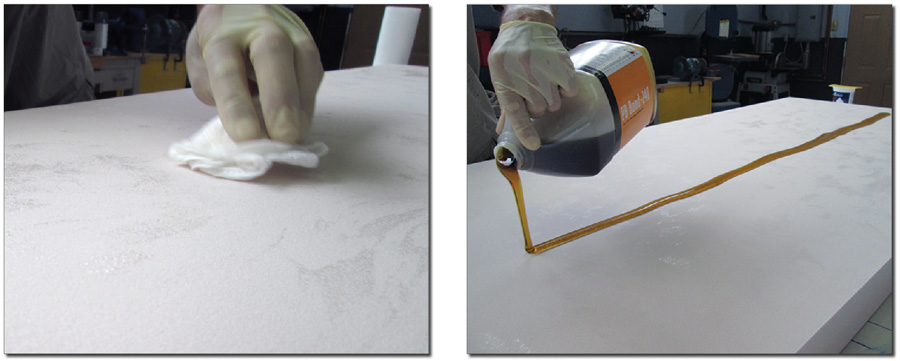
(Left) Spritz water onto both the foam and frame base. Visible puddling should be dabbed with a paper towel. (Right) Next, pour a single strip of PB Bond down the center of the part to be bonded.
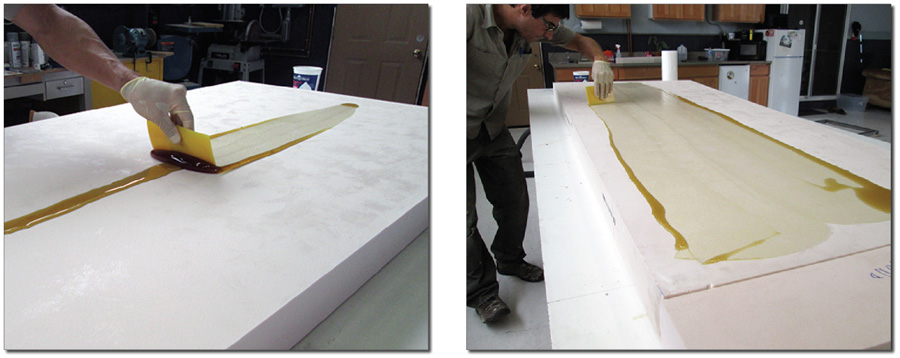
Squeegee the PB Bond so that excess flows evenly on both sides of the squeegee. Work the length of the part, always pushing excess resin to the edge. Since the resin is activated by the surface moisture, avoid excessive squeegeeing, as that will shorten the working time of the resin. A single pass, as shown here, is ideal.
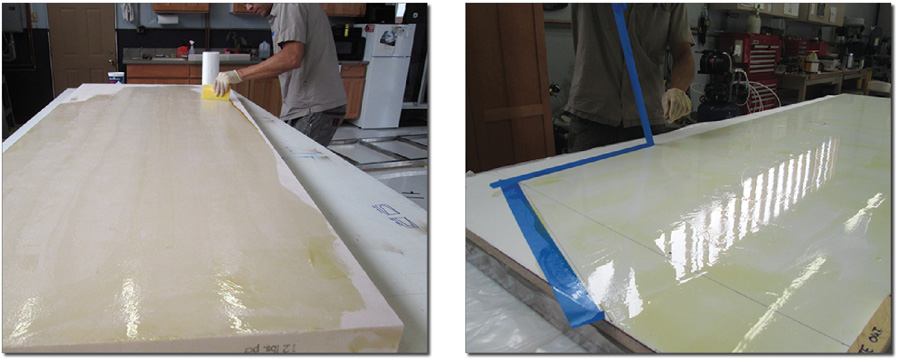
(Left) PB Bond of the foam blank almost finished. (Right) Trim tape removed from the mold base after applying PB Bond.
After making the bag, place the mold frame on one half of the bag, with the other half of the bag neatly rolled up, ready to unfold to form an envelope once you are ready to bag the foam to the base. Regardless of which bagging method you use, be sure to allow several inches of slack around the edges so that the bag can pull tight against the blank without bridging large unsupported gaps. In addition, inserting cheap, low-density foam sheet on the backside of the mold between the frame members will help avoid bag holes caused by excessive bridging between the frame and base.
In order to ensure even distribution of vacuum, apply a spider of breather cloth on top of the foam blank, with arms that extend to the base. These arms will bond to the mold at the squeeze-out line, so use only enough to distribute vacuum evenly—one arm every 18-24 inches is adequate. Because the foam has a tendency to shift on the base when vacuum is pulled, you may also wish to screw formers to the base to lock the foam in place once it is assembled. In contrast to an actual part layup, it is not necessary to pull full vacuum on the assembly—15 inches Hg is sufficient. The goal is to get a small amount of squeeze-out between the foam and base. Here are some additional tips for bonding Precision Board to melamine-surfaced particleboard:
1. Although PB Bond sticks quite well to melamine, quickly sanding the base with a random-orbit palm sander with 60-grit sandpaper will dull/roughen the surface slightly. This gives an even stronger bond between the PB Bond and melamine.
2. PB Bond is activated by moisture. As such, surfaces must be moistened with water before applying the adhesive. However, surfaces should be just barely moist. For the base, wipe the melamine with a damp rag immediately before applying PB Bond. This is sufficient. Visible droplets indicate excessive moisture. On the foam surface, spritz with a mister and then view the surface at an oblique angle. Any visible moisture should be dabbed dry with a paper towel—don’t worry, the pores of the foam will retain sufficient moisture. Ideally, the surface will appear dry, but when you press your lips against the foam, you should be able to feel the moisture in the pores. (Yeah, I know, kissing your molds is probably not in the Boeing production manual, but it works. I love my molds!)
3. PB Bond expands significantly, so per the Coastal Enterprises video, apply only enough PB Bond to change the color of the surface. Do not work the adhesive around excessively: Pour a single thick line down the center of your foam, then squeegee towards the edge of the part once. The more you move the adhesive around by squeegeeing, the more quickly the adhesive is activated and begins expanding. Scrape excess adhesive into a paper cup to discard; do not return to the original bottle! Also be sure to cap the bottle when finished to avoid absorbing atmospheric moisture.
4. Uncured PB Bond is a sticky mess. If immediate cleanup is required, use a solvent. Otherwise, spritz with water, which accelerates the cure, then peel/scrape off once it has cured.
5. One gallon of PB Bond will cover approximately 200-250 square feet.
6. Be sure to place a hard shim underneath your vacuum pickup inside the bag to make sure not to suck it into and dent the tooling foam.
7. For foam blanks that are smaller than the base to which they are mounted, tape off that part of the base that doesn’t need to be bonded before applying PB Bond. This minimizes adhesive waste, makes debagging easier, and results in a more professional looking mold.
Fixture to CNC table
Once you have bonded the tooling foam to your frame, you will need to weld feet (2×2-inch angle, about 1.5 inches wide works well) to the frame in order to bolt it to the CNC table. You want to avoid warping the blank when you bolt it down, so the first step (if you have access to the machine during downtime) is to place the blank on the table in the exact position and orientation you want it located for machining. Then apply pressure at the corners, looking for any wobble, and shim as necessary so that the blank is uniformly supported (the CNC operator should have brass shims for this). Then place the feet in their respective positions and mark the bolt hole centers based on crosshairs extended from the hole (you can draw these on the table with an ultra-fine-tip Sharpie and remove later with rubbing alcohol). Remove the feet, drill the bolt holes, replace the feet on the table to check proper alignment with the bolt holes, and weld in place.
It is quite possible the CNC operator may not want you welding in situ on their table (!), so be sure to discuss before arriving at the shop how they suggest affixing the feet. Another option is to simply weld the feet on according to the table hole diagram, and shim the feet/drill attachment holes once the blank is on the table. The main point is to firmly affix the blank to the table without inducing any frame warping when bolting down.

Affixing the mold blank to the CNC table: 1. Mark the bolt hole with extended line crosshairs. 2. Place the foot over the crosshairs and transfer the lines to the foot. 3. Drill bolt hole in foot and check for fit with bolt. 4. Leaving bolt in place to ensure proper alignment, weld foot to frame.
Troubleshooting
Occasionally you will encounter problems machining the blank: forgetting to change tool heads, inadvertent tool paths, or mismatching the file with the foam blank. Here are several tips for dealing with such issues:
1. Avoid them. Be sure to take a few minutes to preview the mold file on the computer to make sure it’s the right one. It is advisable to machine a small “L”/”R”/”T”/”B” (left/right/top/bottom) into your mold to distinguish between symmetrical, chiral, or similar molds.
2. Have the CNC operator run a toolpath simulation to ensure there won’t be problems with tool depth or collet interference on deep molds. This is standard procedure in most shops. Most molds with an upper and lower/left and right part (i.e., wing or fuselage molds) typically have some kind of locator pins or balls incorporated into the mold. If you place these features at the corners or extremities of the mold, you can machine them (along with the mold identifier letters) as a separate file before the main surfacing file. This will allow you to see that you have the right surfacing file loaded, and that it will fall within the boundaries of the foam blank.
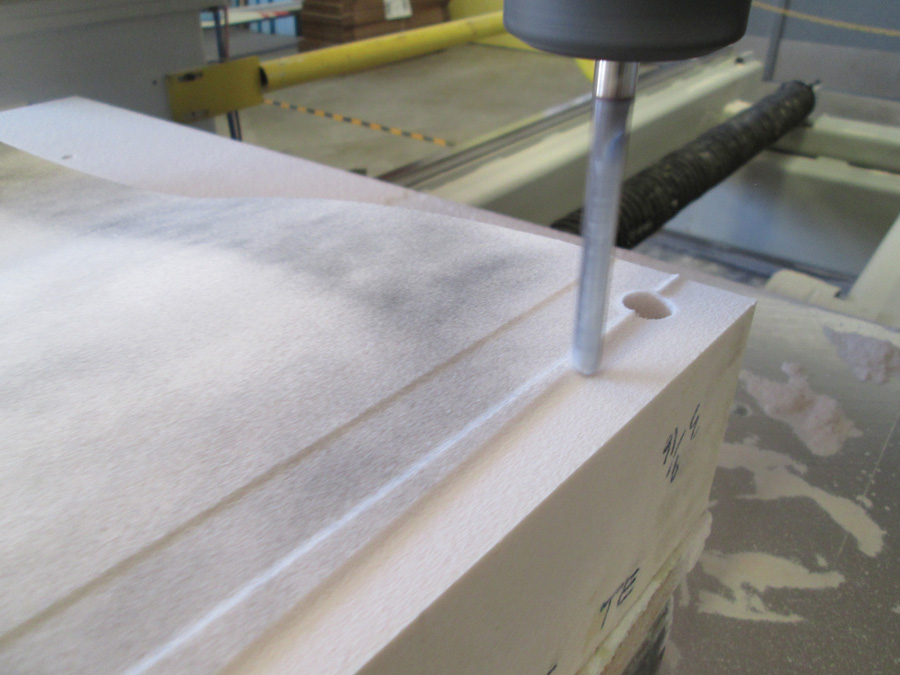
This mold needed reprofiling, so a light coat of black guide coat was applied to ensure the toolhead was cutting new material.
3. When sizing foam, give yourself at least half an inch of foam between the base and the lowest surface cut. This ensures two things: first, if for whatever reason there is a pocket of missing adhesive between the foam and the base, sufficiently thick foam will maintain enough structural integrity to resist warping during machining. On the other hand, if you have only 1/8 inch of foam floating above an air pocket between the foam and base, it’s likely to deform as the tool head moves over it. Secondly, a thick base provides a margin to lower the tool head slightly and resurface/recut if necessary.
4. Heavier-density foams may chip if the speed or draft of cut is too aggressive. If you damage an otherwise acceptable mold this way, you can “bondo” a filler such as 3M Platinum Plus Glaze and re-machine. Additionally, if you are doing a low profile recut and want to ensure that indeed you have removed material, you can paint the part with a black guide coat.
5. Dents or other imperfections in otherwise finished molds should be filled with a filler of similar density, to avoid high or low spots when sanding back to flush. Revchem Composites offers surface densifiers that mimic gel coat, although be aware that PB Board is a closed-cell foam, and surface treatments will only penetrate about 1 mm, so they will only be as structurally sound as the foam supporting them. A gel-coat like surface finish can be achieved on molds by painting high-density (30 pounds or higher) foam with several coats of two-part epoxy primer like PPG’s DP90LV.
6. The cost of a mold is probably significantly higher than the cost of the part it will make. For this reason, treat the mold assembly process with as much, or even greater, quality control as you would apply to a molded part. Make sure you have backup supplies and manpower if things go awry and backup power/vacuum pumps when you assemble the foam to the base.
That’s it for assembling foam blanks. In the next pair of articles, Ken Krueger will describe how to use 3D printing to fabricate molds for small parts. That will complete our look at mold making, and then we’ll move on to fabricating coupons to dial in your layup process.
![]()
Eric Stewart is designing and building the SR-1, a speed plane for setting records in the FAI c-1a/0 category (takeoff weight less than 661 pounds, including pilot and fuel). You can see more at facebook.com/TheSR1Project, including additional photos and videos of the subjects in this series of articles.

